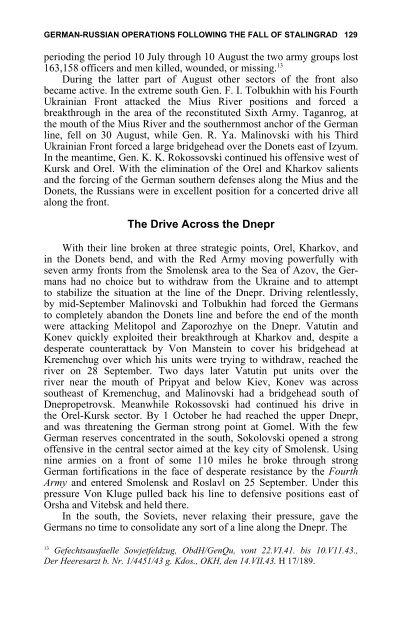the soviet partisan movement 1941-1944 by edgar m. howell
the soviet partisan movement 1941-1944 by edgar m. howell
the soviet partisan movement 1941-1944 by edgar m. howell
You also want an ePaper? Increase the reach of your titles
YUMPU automatically turns print PDFs into web optimized ePapers that Google loves.
GERMAN-RUSSIAN OPERATIONS FOLLOWING THE FALL OF STALINGRAD 129<br />
perioding <strong>the</strong> period 10 July through 10 August <strong>the</strong> two army groups lost<br />
163,158 officers and men killed, wounded, or missing. 13<br />
During <strong>the</strong> latter part of August o<strong>the</strong>r sectors of <strong>the</strong> front also<br />
became active. In <strong>the</strong> extreme south Gen. F. I. Tolbukhin with his Fourth<br />
Ukrainian Front attacked <strong>the</strong> Mius River positions and forced a<br />
breakthrough in <strong>the</strong> area of <strong>the</strong> reconstituted Sixth Army. Taganrog, at<br />
<strong>the</strong> mouth of <strong>the</strong> Mius River and <strong>the</strong> sou<strong>the</strong>rnmost anchor of <strong>the</strong> German<br />
line, fell on 30 August, while Gen. R. Ya. Malinovski with his Third<br />
Ukrainian Front forced a large bridgehead over <strong>the</strong> Donets east of Izyum.<br />
In <strong>the</strong> meantime, Gen. K. K. Rokossovski continued his offensive west of<br />
Kursk and Orel. With <strong>the</strong> elimination of <strong>the</strong> Orel and Kharkov salients<br />
and <strong>the</strong> forcing of <strong>the</strong> German sou<strong>the</strong>rn defenses along <strong>the</strong> Mius and <strong>the</strong><br />
Donets, <strong>the</strong> Russians were in excellent position for a concerted drive all<br />
along <strong>the</strong> front.<br />
The Drive Across <strong>the</strong> Dnepr<br />
With <strong>the</strong>ir line broken at three strategic points, Orel, Kharkov, and<br />
in <strong>the</strong> Donets bend, and with <strong>the</strong> Red Army moving powerfully with<br />
seven army fronts from <strong>the</strong> Smolensk area to <strong>the</strong> Sea of Azov, <strong>the</strong> Germans<br />
had no choice but to withdraw from <strong>the</strong> Ukraine and to attempt<br />
to stabilize <strong>the</strong> situation at <strong>the</strong> line of <strong>the</strong> Dnepr. Driving relentlessly,<br />
<strong>by</strong> mid-September Malinovski and Tolbukhin had forced <strong>the</strong> Germans<br />
to completely abandon <strong>the</strong> Donets line and before <strong>the</strong> end of <strong>the</strong> month<br />
were attacking Melitopol and Zaporozhye on <strong>the</strong> Dnepr. Vatutin and<br />
Konev quickly exploited <strong>the</strong>ir breakthrough at Kharkov and, despite a<br />
desperate counterattack <strong>by</strong> Von Manstein to cover his bridgehead at<br />
Kremenchug over which his units were trying to withdraw, reached <strong>the</strong><br />
river on 28 September. Two days later Vatutin put units over <strong>the</strong><br />
river near <strong>the</strong> mouth of Pripyat and below Kiev, Konev was across<br />
sou<strong>the</strong>ast of Kremenchug, and Malinovski had a bridgehead south of<br />
Dnepropetrovsk. Meanwhile Rokossovski had continued his drive in<br />
<strong>the</strong> Orel-Kursk sector. By 1 October he had reached <strong>the</strong> upper Dnepr,<br />
and was threatening <strong>the</strong> German strong point at Gomel. With <strong>the</strong> few<br />
German reserves concentrated in <strong>the</strong> south, Sokolovski opened a strong<br />
offensive in <strong>the</strong> central sector aimed at <strong>the</strong> key city of Smolensk. Using<br />
nine armies on a front of some 110 miles he broke through strong<br />
German fortifications in <strong>the</strong> face of desperate resistance <strong>by</strong> <strong>the</strong> Fourth<br />
Army and entered Smolensk and Roslavl on 25 September. Under this<br />
pressure Von Kluge pulled back his line to defensive positions east of<br />
Orsha and Vitebsk and held <strong>the</strong>re.<br />
In <strong>the</strong> south, <strong>the</strong> Soviets, never relaxing <strong>the</strong>ir pressure, gave <strong>the</strong><br />
Germans no time to consolidate any sort of a line along <strong>the</strong> Dnepr. The<br />
13<br />
Gefechtsausfaelle Sowjetfeldzug, ObdH/GenQu, vont 22.VI.41. bis 10.V11.43.,<br />
Der Heeresarzt b. Nr. 1/4451/43 g. Kdos., OKH, den 14.VII.43. H 17/189.
















